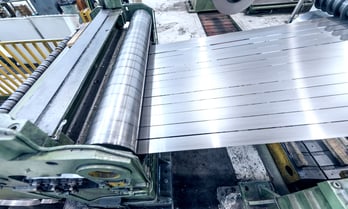 Aluminum and steel are pillars of the metal manufacturing industry. Both aluminum and steel are synthetic alloys; in other words, they don’t appear in nature and must be created using other basic elements. Aluminum must go through ha few phases before it appears like the shiny silver metal that you’re familiar with. The base ingredient of aluminum is a mineral called bauxite, which is mined primarily in tropical areas. The bauxite is ground into a thick paste called alumina, which is then smelted with molten cryolite and shocked with electricity. The ions separate, and the residual liquid cools and becomes aluminum.
Aluminum and steel are pillars of the metal manufacturing industry. Both aluminum and steel are synthetic alloys; in other words, they don’t appear in nature and must be created using other basic elements. Aluminum must go through ha few phases before it appears like the shiny silver metal that you’re familiar with. The base ingredient of aluminum is a mineral called bauxite, which is mined primarily in tropical areas. The bauxite is ground into a thick paste called alumina, which is then smelted with molten cryolite and shocked with electricity. The ions separate, and the residual liquid cools and becomes aluminum.
Steel, however, is a mixture of the elements iron and carbon. Iron is mined, smelted, and then the impurities are removed before carbon is added, resulting in carbon steel. This is used as the base for other types of steel.
Inevitably, both materials have their pros and cons when used in metal fabrication projects. This blog post will cover some of the basic differences between the two.
Heat Conduction Properties
Aluminum is often used as a heat sink for computers and in cooling systems for vehicles because it has superior thermal conductivity. Stainless steel is not as good at transmitting heat; however, it does have a higher melting point than aluminum and can be used across a wider range of temperatures.
Electrical Conductivity
Aluminum is a good conductor of electricity, while stainless steel is not at all known for its conductive properties. Since it is not a good conductor of electricity, and considering its light weight properties as well as its ability to resist corrosion, it’s common to see aluminum sheet metal used in high-voltage overhead power lines, car radiators, and air conditioning units.
Ability to Resist Corrosion
Stainless steel is composed of iron, nickel, manganese, copper, and chromium. The chromium is an added agent that helps to resist corrosion. Beyond that, steel is also non-porous, which makes it more likely to corrode. So, steel needs to be painted or powder coated to prevent rust and corrosion.
On the other hand, aluminum has high oxidation, which makes it highly resistant to corrosion because of its passivation layer. Steel is often used in architecture beams and frames while aluminum is suitable for aircraft, since it’s known for its light weight and flexibility.
Weight Considerations
One of the biggest differences is in the material’s weight. To be frank, carbon steel is quite heavy. Aluminum is often preferred for some applications due to it’s lightweight composition. Steel is much denser when compared to aluminum, which causes it’s weight to skyrocket. While mild steel is lighter than its carbon counterpart, it’s much flimsier than aluminum at the same weight. So, in the weight category, aluminum is a bit better than steel. Overall, it’s a very lightweight yet sturdy material.
Strength & Durability
How strong is aluminum compared to steel?
Aluminum strength vs. steel strength is not even close in most cases. The amount of carbon in steel makes it unyielding (and heavy). This is especially true for carbon steel -- the higher the amount of carbon in an alloy, the harder it becomes.
Mild steel is a "low carbon" steel, which is why it's so flimsy compared to other steels and aluminum (and much cheaper in comparison).
CAMM Metals | Metal Fabrication Projects
Still not sure which one is right for your project needs? You can dive deeper with more research or call CAMM Metals at 860-292-6260 and we would be more than happy to assist you.We have years of experience, honing our skills across the board to deliver a quality product and measurable bottom line value to our customers.



